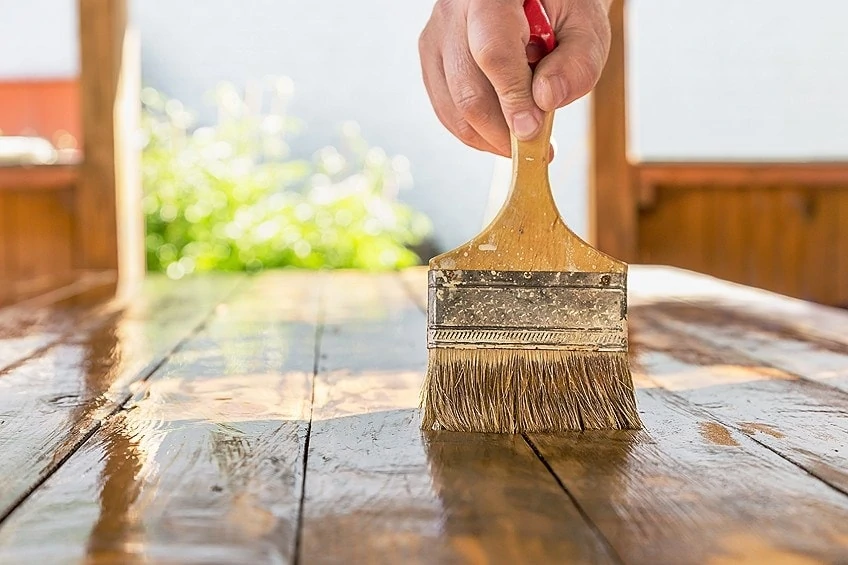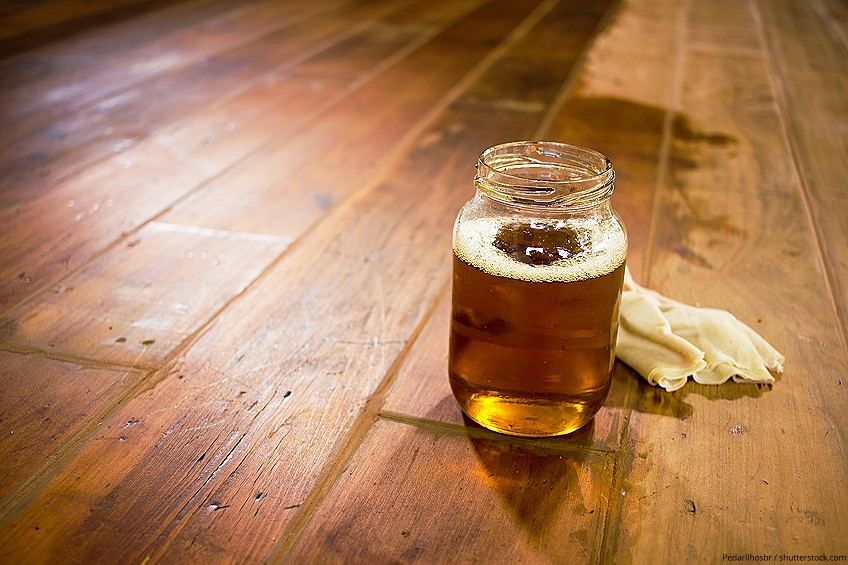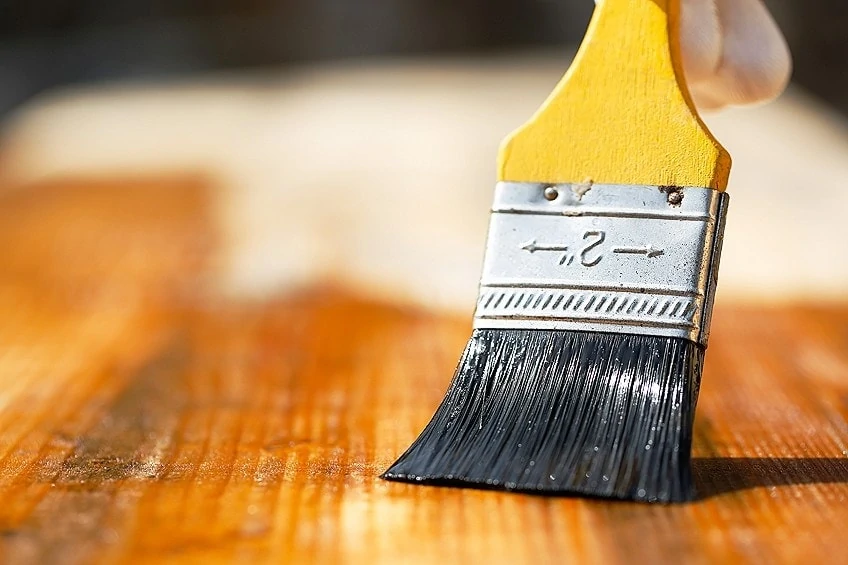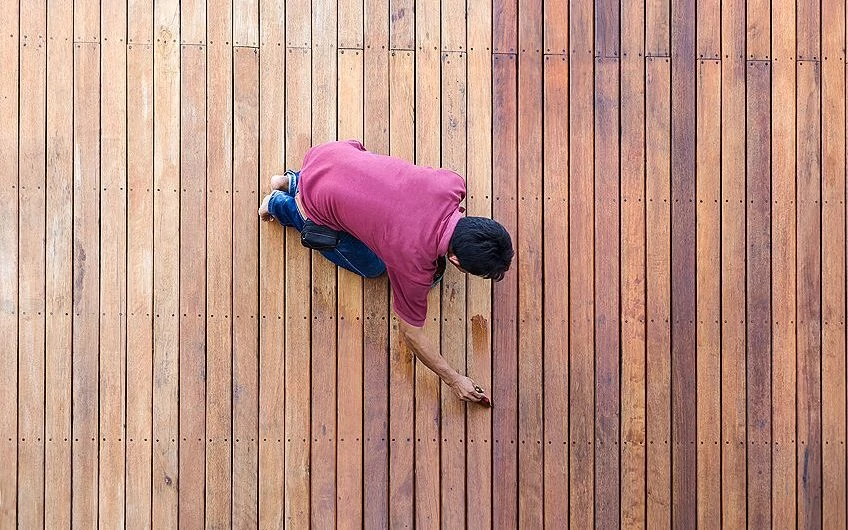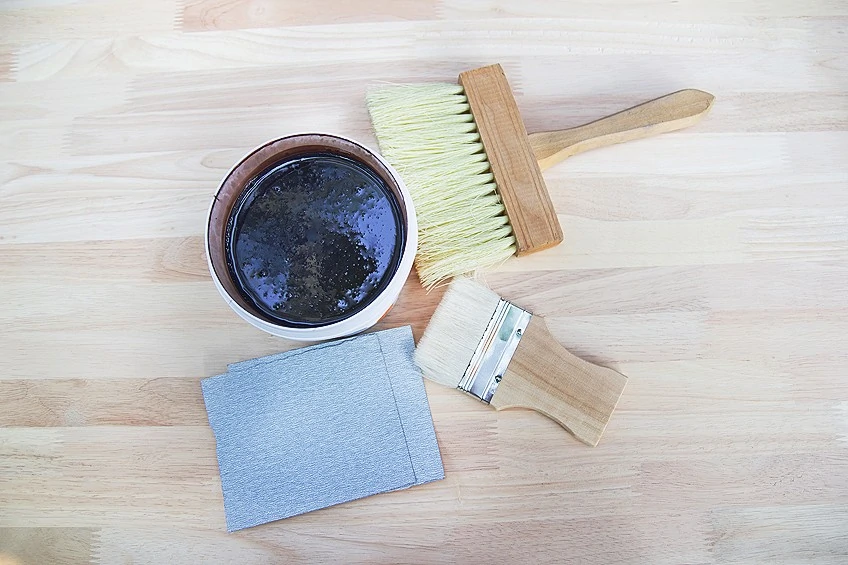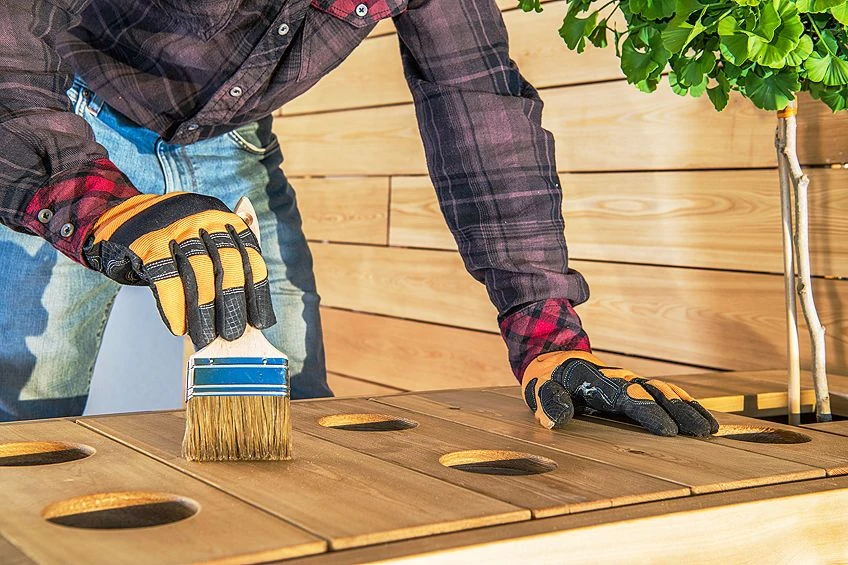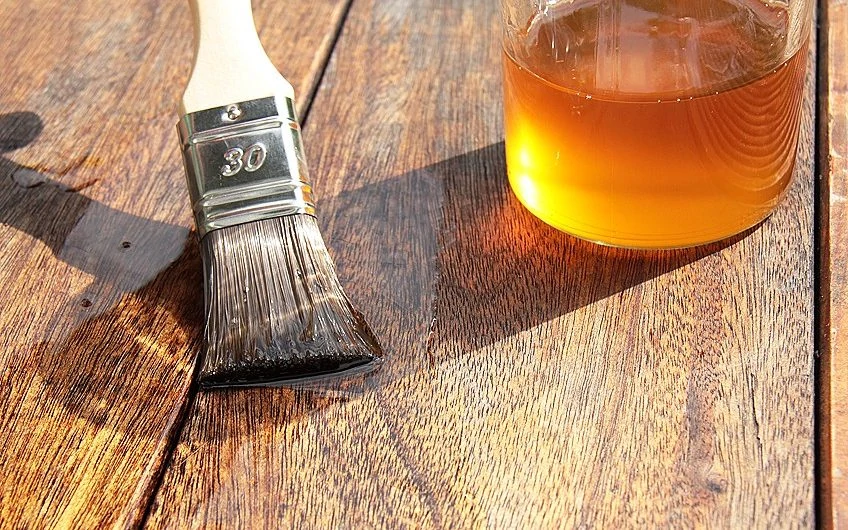Best Outdoor Wood Sealer – Find your Suitable Wood Sealant
This post may contain affiliate links. We may earn a small commission from purchases made through them, at no additional cost to you. You help to support resin-expert.com
To maintain your exterior spaces and retain their shine, you will need to find the best outdoor wood sealer and masonry sealer products. Outdoor sealant produces a topcoat that provides protection, water-resistance and updates the surface of walkways, fences, patios, decks, and driveways. As you learn more about how to use wood sealant, you will look at waterproofing products, stains, color sealers, and other outdoor sealant types. We have put together this guide to familiarize you with the various outdoor sealants available and help you select the best water sealant for your purposes.
Table of Contents
Why Should I Seal Exterior Wood?
Wood is attractive in its natural state, however, should you wish to maintain its appearance in exterior areas, the use of a wood sealant is required. As wood is porous by nature, it tends to absorb water rather easily and this will be damaging long term.
Wood that has been exposed to humid or rainy conditions can warp, peel, swell or even rot. Sealing the surface of wood can prolong the lifespan of your fence, outdoor furniture, or deck, and they won’t need to be repaired or replaced after a season of wet weather.
Outdoor sealers for wood can also update the wood’s appearance. The various wood stain and paint products available offer waterproofing and protection from natural deterioration and aging. A wood stain can restore weathered-looking wooden items to their former glory, or even change their appearance to suit the look of your house.
If you are planning to paint or stain a wooden surface, sealing it first will increase the durability and longevity – especially if you aren’t using a 2-in-1 outdoor sealer and stain product.
How to Waterproof Wood?
There are 3 definitive methods for the long-term waterproofing of wood.
- By using either tung or linseed oil, you get a protective coating while also achieving an attractive hand-rubbed look to the surface.
- Applying varnish, polyurethane, or lacquer.
- Using a stain and sealant combination product that provides waterproofing and seals in one finish.
Whichever method suits your situation, remember that there are certain ways to waterproof and seal that might specifically suit either indoor or outdoor surfaces, whilst there are other products aimed at treating darker or lighter grained wood.
Best outdoor wood sealer
It may be a challenge finding the most effective outdoor wood sealant for your needs. So we picked out a few products to make your choice easier.
Helmsman Spar Urethane from Minwax – a High Quality Solution
Helmsman® Spar Urethane by Minwax is a transparent, water-based finish designed to provide wood with a protective coating to resist harsh conditions.
- Formulated with UV resistance that reduces graying and fading from the sun.
- Creates a layer of protection that guards against rain and moisture.
- Contains specially formulated oils allowing the finish to contract and expand as the wood reacts to temperature and seasonal changes.
- Well suited for use outdoor furniture, windows, doors, skirting, kitchen countertops, bathroom cabinets, and bar tops.
- A completely transparent finish is perfect for use over lightly-colored wood and stain coatings.
- Dries rapidly and is easy to clean with warm water.
- Contains UV blockers to reduce the sun's graying and fading effects
- Forms a protective barrier against rain and moisture
- Special oils allow the finish to expand and contract with the wood
PROS
- Offers easy application and dries rapidly.
- Several similar products offer protection from the elements, however this also provides protection from temperature and seasonal changes in wood.
- Effectively prevents graying or fading of wood surfaces.
CONS
- Although it is also suitable for indoor use, be aware of the fumes and ensure the room has sufficient airflow.
- Not the most affordable solution.
Premium Water Sealer from Rain Guard – An Affordable Choice
This Premium Water Sealer from Rain Guard is a solvent-based type of sealant that penetrates wood effectively with its Micro-Lok patented formula. This provides powerful waterproof protection, and once correctly applied the wood surface is guarded from UV, frozen conditions, rain, dirt, salt, and other potential hazards, specified by the manufacturer.
This sealant is suitable for most porous types of wooden surfaces and is totally transparent, so it won’t change the wood’s appearance. The environmentally conscious formula is safe enough for use in the presence of pets, plants, and people. It also requires no additional preparation, so you can use it directly out of the packaging. It offers outdoor wood surfaces protection from degradation and rot while preventing the spread of mold, mildew, and more. The product is ideally suited to wood but allows application on various other surface types, such as walkways, driveways, and outdoor walls.
- Prevents surface damage from rain, snow, ice, and efflorescence
- Does not alter surface appearance and will not leave a surface film
- Contains advanced UV stabilizers to ensure non-yellowing surface
PROS
- Surface coating guaranteed up to 5 years
- Offers area coverage of approximately 200 square feet(±60.9m²) per gallon(3.78l)
- UV protective formula
- Provides lasting durability and prevents yellowing
- Not hazardous to pets, plants, or people
CONS
- Available exclusively in a transparent coating
WaterSeal Wood Protector from Thompson’s – Best Clear Wood Sealant
This Wood Protector from Thompsons provides a high durability transparent sealant solution. It offers protection from water degradation and preserves the wood’s natural hue. Thompsons has been operating for over a century, focusing on the development of quality wood sealants and essential home improvement products. These sealant products are all manufactured and packaged in the USA.
- High durability transparent sealant solution
- It offers protection from water degradation and preserves the wood’s natural hue
- Very good UV protection
PROS
- Transparent coating provides resistance against UV damage and mildew
- Ships in a practical metal container with a handle
- Proven excellent results
- Preserves appearance of wood, while offering protection
CONS
- Does not allow application on damp wood
- Limited protection from humid conditions
Star Brite Golden Teak Oil Sealer – Best Oil Sealer
This is a high-end sealant solution for marine teak and various fine wood types. It also preserves the wood and produces an exceptionally authentic finish. This type of natural-oil-based sealant creates a protection layer, guarding wood’s surface from saltwater and extreme weather conditions, making it perfectly suited for exterior use on decks, or outdoor furniture, etc.
Initially, the wood requires thorough cleaning and needs to be completely dry before you begin the application. You can use a sponge, a clean white cloth, or a brush to apply it, but ensure you work in the direction of the grain of the wood. This way the wooden surface absorbs the oil far more effectively. Then you can allow the oil a minimum of 5 minutes to seep in before using a clean cloth to wipe away any excess.
- Advanced tung oil polymers provide maximum protection for wood
- UV absorbers protect against sun damage, weathering and fading
- Easy to use, fast drying; ideal for boats, pools, and wood furniture
PROS
- This is developed for teak and other high-quality wood types, so it is able to effectively deal with the problems specific to these kinds of wood.
- Complements the authenticity of teak’s appearance, adding a golden shimmer to the surface.
- Protects teak from saltwater.
- Also offers protection from UV damage.
CONS
- Requires a good deal of preparation, as the wood requires cleaning, scrubbing, rinsing, and drying, before applying the sealant.
- High-end product with a high price-tag.
Clear Deck Waterproofing by Defy – Best for Composite Decks
We recommend sealing weathered composite wood items, and this high durability waterproof sealant is ideal for this purpose. You can now avoid those unattractive black stains that sometimes show up when a composite deck surface is allowed exposure to water.
This Composite Deck sealant from Defy has a formula enhanced with zinc particles that effectively block UV. Not only do these additives prevent fading but they also offer protection from mold and mildew. One coating alone can prolong your composite deck’s lifespan by decades.
The completely transparent coating doesn’t change the wood’s appearance in any way, and while it is ideally suited for use on composite decks, it also allows use on various other natural materials. The area coverage is up to 200 square feet(±60.9m²) per gallon(3.78l), and it offers easy application and an all-around cost-effective solution. Ensure your deck is completely clean before applying the sealant.
- A water-based semi-transparent wood stain
- Fortified with zinc nano-particle technology for UV protection
- Easy to apply and maintain on exterior surfaces
PROS
- Transparent, water-based composite deck sealant
- Formula is enhanced with zinc nano-particles
- High durability resin
- Low maintenance finish, allowing reapplication directly over existing treatments
CONS
- Exclusively for use with composite decks
How to Seal Outdoor Wood
Sealing wood in exterior areas can be tricky, especially when making your first attempt at it. Together, we’ll take a closer look at just how to go about it.
METHOD 1: Produce a Glowing, Hand-Rubbed Oil Finish
Linseed oil, produced from flax seeds, and Tung oil, from the Tung tree of Chinese origin, form the foundation for most hand-rubbed or wiped oil finishes.
A method used for hundreds of years up to this day, with some further developments, the oils enhance and preserve rich darker grained woods like mahogany and walnut. Combining the oils with various additives can allow the finish to dry more rapidly and reduce stickiness. There are pre-mixed Tung and linseed oil products available, or you can simply blend your own combination for a completely customized finish. The ratio of typical hand-rubbed oil mix contains a single part either Tung or boiled linseed oil, a single part polyurethane, and a single part mineral spirits.
Here’s how to apply yours:
- Ensure you are thorough when stirring the mixture.
- Use a brush with natural bristles for application on darker-grained wood that is already cleaned and sanded. (If you need to seal wood of a lighter hue, like pine or ash, skip this technique and use one of the next two; hand-rubbed oils are prone to yellowing over time.)
- Allow the oil to seep in beneath the wood’s surface, reapplying to areas that appear dry.
- Wipe away oil residue, rubbing effectively using pieces of clean, dry cloth will remove the excess.
- Let the wood dry out completely. This process may take only a few hours or even overnight, depending on the level of oil in the blend used.
- Use sandpaper with a fine grit to sand the surface.
- Keep repeating this process, applying as many additional layers as is necessary to produce the finish you need.
Once you understand oil-rubbed blends, you can improvise on the formula. For a higher viscosity level, use less mineral spirits. Should you need to increase the length of the drying process, add less polyurethane. Alternatively, you can also use additional polyurethane to speed up the drying and produce a shinier finish. There are endless customizable blending options to suit your project’s needs!
Note: It is possible for a cloth saturated with oil to combust spontaneously. As it dries, the oil can generate heat and it may burst into flames without any ignition source. Be sure to keep a water bucket closeby and simply drop the cloth into it once it has become saturated with oil. You can continue working with a clean cloth and let the used cloth pieces hang separately to dry afterward. Once they have dried completely, you can dispose of them risk-free, but never use the same cloth twice.
METHOD 2: Use Sealants for Best Protection
Varnish, lacquer, and polyurethane, are proven sealant types and highly effective waterproofers. You can apply these using a spray unit or brush, once you’ve ensured your surface is sanded and completely clean. After this, allow it to properly dry before you lightly resand and apply additional coats.
For an optimal resulting finish, perform your application at room temperature. Try not to ever shake wood sealant or stir it too fast before applying it, as this can produce air bubbles that may stay on the surface even after drying.
These sealant types may dry rapidly(certain products need only 15 minutes), however, they are usually formulated with chemical solvents, so good airflow is essential in your work area.
Here are some advantages and disadvantages characteristic of commonly used sealants types:
- Polyurethane sealants are formulated with various solvents, including polyurethane resins and acrylic resins that help produce your desired finish. This could be anything from a soft, gentle sheen to a glossy shine coating. Modern polyurethane isn’t prone to yellowing, making it an excellent choice for lighter-colored wood varieties. Oil-based polyurethane provides the most durable finish, however you will need turpentine or mineral spirits for cleaning your brushes. While water-based polyurethane allows cleaning with soapy water.
- Varnish, formulated with solvents, resin, and drying oil, produces a hard, protective shell that avoids scratching and yellowing. Marine varnish is used for waterproofing wood in exterior situations, and it is also formulated with UV absorbing agents to protect wood from direct sunlight. Spar varnish is effective for indoor use, such as tables where it offers great resistance to cup rings. After application, your brushes can be cleaned with mineral spirits or turpentine.
- Lacquer, a solution of reduced tree resin or synthesized resin in alcohol, is a wood sealant favored for furniture. Its tendency to exhibit a yellow hue in time may be thought to be unsightly on lightly colored wood types, but wood lacquer can enhance the luxurious feel of deeper wood tones while providing a finish that protects it from scratches. You can choose from a range of different sheens, and offers easy thinning with a lacquer thinner product. Apply several thin coatings for the best resulting finish, but keep in mind that lacquer does produce highly toxic fumes, so a workspace with good airflow is important. Work in an outdoor area if possible or open your windows and use fans to increase air circulation.
METHOD 3: Work Fast with Stain-Sealant Combos
If time is a crucial factor, or you are taking on a larger area like a deck, opt for a sealer-stain combination. These multipurpose sealants provide color and waterproofing simultaneously. These combo products can be alkyd, oil, or water-based and are formulated with both binding agents and color pigments. The resulting opacity of the finish will depend on the level of pigment the sealant contains. Should you be using a sealer-stain in an outdoor area, you will be required to reapply the coating each year or two to ensure protection.
Except when working with alkyd-based sealants, sealer-stain combos don’t accumulate on the surface of the wood, they are absorbed rather and any residue just evaporates. Alkyd-based sealer-stains produce a lighter coating on the wood’s surface, which makes them a better fit for indoor wooden items like interior exposed wooden beams or authentic furniture, that won’t need further applications.
When applied in exterior situations, alkyd-based sealer-stains are prone to peeling if the surface isn’t completely dry and clean.
Sealer Stain Colors & Transparency
When selecting a wood stain, or combination sealer and stain product, there is a vast range of tones and degrees of opacity to decide on. Your choice will be determined by the age and state of your wood and your personal taste.
Stain Colors
Wood stains can transform even more affordable types of wood, giving it a far more high-end look and feel. If you require an oil or water-based sealant, there is certainly a shade available to suit your aesthetic.
- Transparent wood stains display and enhance the wood’s natural texture and color. They work best with new and ready-stained wood requiring refreshing of its surface. Wood toner products are also usually grouped with these.
- Cedarwood stains are light brown in color with yellow hues that mimic the wood’s natural color. This is excellent for producing an authentic look and feel.
- Redwood stain products range from vivid barn reds to more understated red-browns. These wood stains can inject a distinctive color explosion into the wood’s appearance.
- Brown or Tan wood stains closely resemble the rustic tone of darker wood. These produce a muted but sophisticated feel.
- Gray wood stains can produce a faded, worn tonal range, well suited to seaside houses, or a more solid gray that works more neutrally.
- White wood stains enliven the look, causing them to appear almost painted white, yet still preserving the wood’s authentic texture. In addition, these seep into the wood’s surface, preventing the color from peeling away as white paint does.
Stain Transparency
The level of transparency of a wood stain product will determine its ability to mask the natural grain and color of the wood. This ranges from completely transparent to opaque.
- Clear wood stain products contain low pigment levels and are generally used with a sealant. They also display the natural shade and texture of the wood, which makes them an excellent choice for new, good quality wood.
- Semi-transparent wood stain products are slightly tinted but still display the wood’s natural grain clearly. This type of wood stain is ideal for wood in good condition, without degradation but in need of an updated surface and look.
- Semi-solid wood stains change the shade of the wood, while still displaying some of the texture and grain. This is well suited for wood that has aged 5-10 years.
- Solid wood stains mask the wood’s surface color and texture, so they are well suited for degraded wood that is more than 10 years old. This produces a longer-lasting, simplified look that can hide discoloration and repair work.
Tip: Pigmented sealants and solid wood stain products offer superior protection from UV exposure and are usually longer lasting than clear wood sealants and stains.
Types of Wood
There are certain cases where a different approach is required when treating wood. This depends on the type, but also what state the wood is in.
Wood with Existing Stain
Before you apply the new wood stain coating you will need to go about removing the previous stain layer by sanding the surface. Otherwise, the initial stain coat can appear through the new layer in unsightly patches. Wood stain products that produce a film when applied should be completely sanded away so that a penetrative stain treatment can work effectively.
New Wood
Before applying the wood stain treatment, the wood needs to be dry throughout. Usually, wood that has been pressure treated requires more drying time, as it may contain preservatives. Without complete drying, there is a risk that moisture trapped beneath the surface can lead to wood rot.
Weathered Wood
Weathered wood will require sanding and pressure washing before you begin the wood stain application. In some instances, the process may call for both, but take care you don’t splinter the wood. This happens when the pressure level is too great. When dealing with decks, you might need to replace any planks that are particularly weathered, before you treat the whole surface at once.
Tips for Waterproofing Wood
As you learn more about waterproofing wood, you should remember the following pointers:
- Ensure your surface has been properly cleaned and you’ve removed any fibers or loose pieces of wood before you start the application of your sealant.
- If your surface has undergone previous treatment, any paint, sealant, or stain coatings can be removed with a scraper and then sanded down to expose the bare wood surface.
- You can assess the waterproofing of your deck using a water drop test. Pour some water droplets onto one of the planks. Should the water start to bead, then the wood is sealed but the deck will require retreatment if the plank absorbs the water.
- You can also find combination coatings that allow you to prime and seal the surface at once which can reduce application time.
- If you are planning to apply paint directly over the sealant layer, be sure to select a product that allows this, or the adhesion of the paint may prove ineffective.
- Be sure to follow the product guide to find out which application methods are best for your wood sealant and when you will need to reapply.
Frequently Asked Questions
What Type of Protection Do Exterior Wood Surfaces Require?
You might use wood in several areas around your house. Perhaps you built a deck and purchased some outdoor furniture. You may have a garden shed or gazebo, a fence, or wooden railings. So you may need to consider the type of protection these would need.
What is Wood Sealer Used for?
Wood sealant is formulated for preventing degradation to wooden surfaces. All kinds of wood are vulnerable to staining, rot, and damage from water. It also requires protection from the sun, wind, and other environmental hazards.
When using wood in exterior locations, like railings, patios, or decks, it should be treated with a sealant to make it more durable, preserve its image, protect the surface and increase its overall longevity.
Which Wood Sealant is the Most Effective for Exterior Use?
The best exterior wood sealant is exterior penetrating wood stain. This type of wood sealant penetrates deep into the pores of the wood and provides good adhesion that prevents water from seeping in, which avoids the risk of damp and water degradation. These products also contain mildewcide, which stops the growth of mildew and mold.
Certain types of exterior wood sealants also provide UV absorption, protecting the wood from direct sunlight. They come in a wide range of colors in both oil and water-based variants.
How Do you Seal Untreated Wood Outside?
Be sure you assess wood that hasn’t been treated for any traces of mildew or mold. This can be removed with a diluted bleach solution but, be sure to let the wood dry properly afterward. You can then begin sanding any surface of the wood you will be sealing and vacuuming to get rid of any dust from the surface.
Use short, uniform brush strokes following the wood’s grain when applying the wood sealant to the surface. Ensure you coat all of the wood’s surfaces and allow the sealant to dry totally. You can then begin applying the second coat for total coverage.
What Are the Drying Times of Wood Sealants?
The drying time of a wood sealant is dependent on a number of factors, such as the surrounding temperature and humidity, or the kind of wood and stain product you are using for instance. Dryer, less humid conditions make for more rapid drying times, and conversely, should the surrounding atmosphere contain moisture, then this will slow down the drying process considerably.
More fluid wood sealant products without penetrative properties can require a few days or even more than a week in some cases, depending on the atmospheric conditions present. Wood stain products with higher viscosity formulas will set in a few hours once applied, but require up to a few days to dry completely, which is also dependent on humidity and temperature levels. Latex wood sealant has the longest drying time, which is usually 2-3 weeks.
How Do you Seal Outdoor Wood Furniture?
When sealing wooden furniture outdoors, you will require a good quality exterior penetrative wood stain, which you can choose from various shades and colors along with a primer for the surface. The wood will require sanding over the complete area you wish to seal. This will help the primer’s adhesion process. Ensure that you select a dry area with decent airflow for your workspace. Should there be rain or very humid conditions this had better be inside.
Ensure the primer coat is evenly applied to the wood and proceed with the drying process. Then begin applying the wood stain and be sure to spread it evenly upon the wood’s surface. Cover each part thoroughly, this includes the surfaces underneath the arms and legs, as well as the joints. Let the wood stain coating dry properly before taking the item outside or using it.
How Long Does Wood Sealer Last?
The longevity of wood sealant is affected by numerous factors: the sealant type you are using, the weather and climate conditions, the function the wood is serving, and where it is situated. For instance, a light coating of wood stain that doesn’t penetrate its surface and is exposed to a high frequency of contact and use, as well as direct sunlight will not offer the lasting durability of a penetrating wood stain that has been applied to wood in a scarcely used area in the shade. As a rule, a decent wood sealant coating usually lasts approximately 4-5 years.


